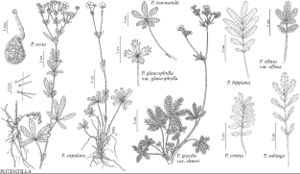Potentilla hippiana
Nov. Stirp. Pug. 2: 7. 1830.
Stems (0.3–)2–4(–5) dm, lengths (1–)2–4 times basal leaves. Basal leaves pinnate to subpinnate, (3–)5–15(–25) cm; petiole 1–10(–15) cm, long hairs abundant to dense, tightly appressed, 1–2.5 mm, stiff, short hairs absent or obscured, crisped-cottony hairs absent or sparse to common, glands absent or obscured; leaflets not conduplicate, lateral ones evenly (to unevenly in argyrea phase) paired, (2–)3–6(–7) per side on distal (1/6–)1/5–1/2 of leaf axis, distal pairs ± decurrent, often confluent with terminal leaflet, larger leaflets oblanceolate or narrowly obovate to oblong, 1–5(–6) × 0.3–1.5 cm, distal (2/3–)3/4 to whole margin incised 1/2 or less (rarely more) to midvein, teeth (5–)7–12(–18) per side, 1–4 mm, surfaces ± to strongly dissimilar, abaxial white, long hairs abundant (mostly on, but not limited to, veins), 1–2 mm, stiff, short hairs absent or obscured, crisped-cottony hairs abundant to dense, glands absent or obscured, adaxial green to grayish, long hairs sparse to common, rarely absent, short or crisped to, sometimes, cottony hairs absent or sparse to common, glands sparse. Cauline leaves 1–2(–3). Inflorescences 10–30-flowered. Pedicels 0.3–3(–5) cm. Flowers: epicalyx bractlets narrowly elliptic to lanceolate, rarely linear, 2–5 × 0.5–1.5 mm, (1/2–)2/3 as long as sepals, abaxial vestiture similar to or ± sparser than sepals, usually not glabrescent, straight hairs ± abundant, crisped to sometimes ± cottony hairs absent or sparse to abundant; hypanthium 3–7 mm diam.; sepals 4–5.5(–6.5) mm, apex acute to acuminate; petals 4–8 × 4–7 mm; filaments 0.5–2.5 mm, anthers 0.6–1.1 mm; carpels (5–)10–30, styles 1.7–2.5 mm. Achenes 1.4–1.8 mm, smooth to faintly rugose. 2n = 42, 70, 77, 84, 98.
Phenology: Flowering summer.
Habitat: Dry grasslands and meadows, in aspen and conifer woodlands or alpine tundra, disturbed sites
Elevation: 500–3400 m
Distribution

Alta., B.C., Man., N.W.T., N.S., Ont., Que., Sask., Ariz., Colo., Idaho, Mich., Minn., Mont., Nebr., Nev., N.Mex., N.Dak., S.Dak., Utah, Wyo.
Discussion
Potentilla hippiana is most common and distinctive in the Colorado Plateau and southern Rocky Mountains, with outliers in the mountains of Arizona, Nevada, and New Mexico. Occurrences are more scattered in the northern Rocky Mountains and Great Plains, where intergradation with P. effusa is common. Among these intermediates are the argyrea phase and the single report from Idaho (B. C. Johnston 1980). Potentilla hippiana is probably adventive in Nova Scotia, eastern Ontario, Quebec, and Michigan, and possibly the Northwest Territories. The reported occurrence in central Alaska (E. Hultén 1968) is based on a specimen of P. pensylvanica (CAN).
Significant variation exists throughout the range of Potentilla hippiana, including dwarfism, leaf division, leaflet dissection, adaxial leaflet vestiture, and pedicel length. Some of this variation might merit taxonomic recognition upon further analysis, especially if correlated with ploidy level (6x through 12x). At present, the differences used to distinguish var. argyrea are not found to be sufficiently correlated with distribution to merit formal taxonomic recognition.
Complicating the infraspecific variation is a tendency for Potentilla hippiana to intergrade with other species, in particular P. effusa. Beyond sect. Leucophyllae, the frequency of hybrids with P. pulcherrima blurs the distinction between the two species; P. gracilis var. hippianoides S. L. Welsh & N. D. Atwood is probably one of the resultant intermediates.
Selected References
None.
